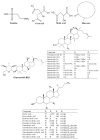Therapeutic Potential of Pien-Tze-Huang: A Review on Its Chemical Composition, Pharmacology, and Clinical Application
- PMID: 31505740
- PMCID: PMC6767116
- DOI: 10.3390/molecules24183274
Therapeutic Potential of Pien-Tze-Huang: A Review on Its Chemical Composition, Pharmacology, and Clinical Application
Abstract
Pien-Tze-Huang (PTH) is a famous and commonly used traditional Chinese medicine formula in China. It was first formulated by a royal physician of the Ming Dynasty (around 1555 AD). Recently, PTH has attracted attention worldwide due to its beneficial effects against various diseases, especially cancer. This paper systematically reviewed the up-to-date information on its chemical composition, pharmacology, and clinical application. A range of chemical compounds, mainly ginsenosides and bile acids, have been identified and quantified from PTH. Pharmacological studies indicated that PTH has beneficial effects against various cancers, hepatopathy, and ischemic stroke. Furthermore, PTH has been used clinically to treat various diseases in China, such as colorectal cancer, liver cancer, and hepatitis. In summary, PTH is a potential agent with extensive therapeutic effects for the treatment of various diseases. However, the lack of information on the side effects and toxicity of PTH is a non-negligible issue, which needs to be seriously studied in the future.
Keywords: Cancer; Chemical composition; Clinical application; Pharmacology; Pien-Tze-Huang.
Conflict of interest statement
The authors declare no conflict of interest.
Figures
Similar articles
-
[Chemome profiling of Pien-Tze-Huang by online pressurized liquid extraction-ultra-high performance liquid chromatography-ion trap-time-of-flight mass spectrometry].Se Pu. 2021 May;39(5):478-487. doi: 10.3724/SP.J.1123.2020.10011. Se Pu. 2021. PMID: 34227332 Free PMC article. Chinese.
-
Research progress on the pharmacological effects and chemical constituents of Pien Tze Huang and its potential Q-markers.Chin J Nat Med. 2023 Sep;21(9):658-669. doi: 10.1016/S1875-5364(23)60400-5. Chin J Nat Med. 2023. PMID: 37777316 Review.
-
Screening and verification of target and molecular docking study of Pien-Tze-Huang in ameliorating alcoholic liver injury in rats.J Pharm Biomed Anal. 2025 Jan 15;253:116517. doi: 10.1016/j.jpba.2024.116517. Epub 2024 Oct 10. J Pharm Biomed Anal. 2025. PMID: 39461065
-
Pien Tze Huang protects the liver against carbon tetrachloride-induced damage.Pharmacol Toxicol. 2002 Oct;91(4):185-92. doi: 10.1034/j.1600-0773.2002.910406.x. Pharmacol Toxicol. 2002. PMID: 12530469
-
How would composite traditional Chinese medicine protect the brain--an example of the composite formula "Pien Tze Huang".Curr Med Chem. 2011;18(23):3590-4. doi: 10.2174/092986711796642535. Curr Med Chem. 2011. PMID: 21756225 Review.
Cited by
-
Case report: Treatment with Pien-Tze-Huang for prolonged positive SARS-CoV-2 test results in COVID-19 patients: A report of five cases.Front Med (Lausanne). 2022 Aug 9;9:860681. doi: 10.3389/fmed.2022.860681. eCollection 2022. Front Med (Lausanne). 2022. PMID: 36017009 Free PMC article.
-
Progress of traditional Chinese medicine in the prevention and treatment of colorectal cancer.World J Gastrointest Oncol. 2025 Jun 15;17(6):105690. doi: 10.4251/wjgo.v17.i6.105690. World J Gastrointest Oncol. 2025. PMID: 40547140 Free PMC article. Review.
-
Uncovering the Mechanism of the Effects of Pien-Tze-Huang on Liver Cancer Using Network Pharmacology and Molecular Docking.Evid Based Complement Alternat Med. 2020 Sep 7;2020:4863015. doi: 10.1155/2020/4863015. eCollection 2020. Evid Based Complement Alternat Med. 2020. PMID: 32963562 Free PMC article.
-
Pien Tze Huang (PZH) as a Multifunction Medicinal Agent in Traditional Chinese Medicine (TCM): a review on cellular, molecular and physiological mechanisms.Cancer Cell Int. 2021 Mar 3;21(1):146. doi: 10.1186/s12935-021-01785-3. Cancer Cell Int. 2021. PMID: 33658028 Free PMC article. Review.
-
Pien-Tze-Huang alleviates lithocholic acid-induced cholestasis in mice by shaping bile acid-submetabolome.Chin Med. 2025 Jul 3;20(1):103. doi: 10.1186/s13020-025-01161-7. Chin Med. 2025. PMID: 40605096 Free PMC article.
References
-
- Commission C.P. Pharmacopoeia of the People’s Republic of China. Chinese Medical Science and Technology Press; Beijing, China: 2015. pp. 573–575.
-
- Xu Y.Y., Yu E.X. Clinical analysis of the effect of Pien Tze Huang in treatment of 42 patients with moderate or advanced liver cancer. Shanghai J. Tradit. Chin. Med. 1994;12:4–5.
-
- Gu Z.X. Preliminary Therapeutical observation of advanced colon cancer. Chin. Tradit. Pat. Med. 1993;15:23.
Publication types
MeSH terms
Substances
Grants and funding
LinkOut - more resources
Full Text Sources
Medical


